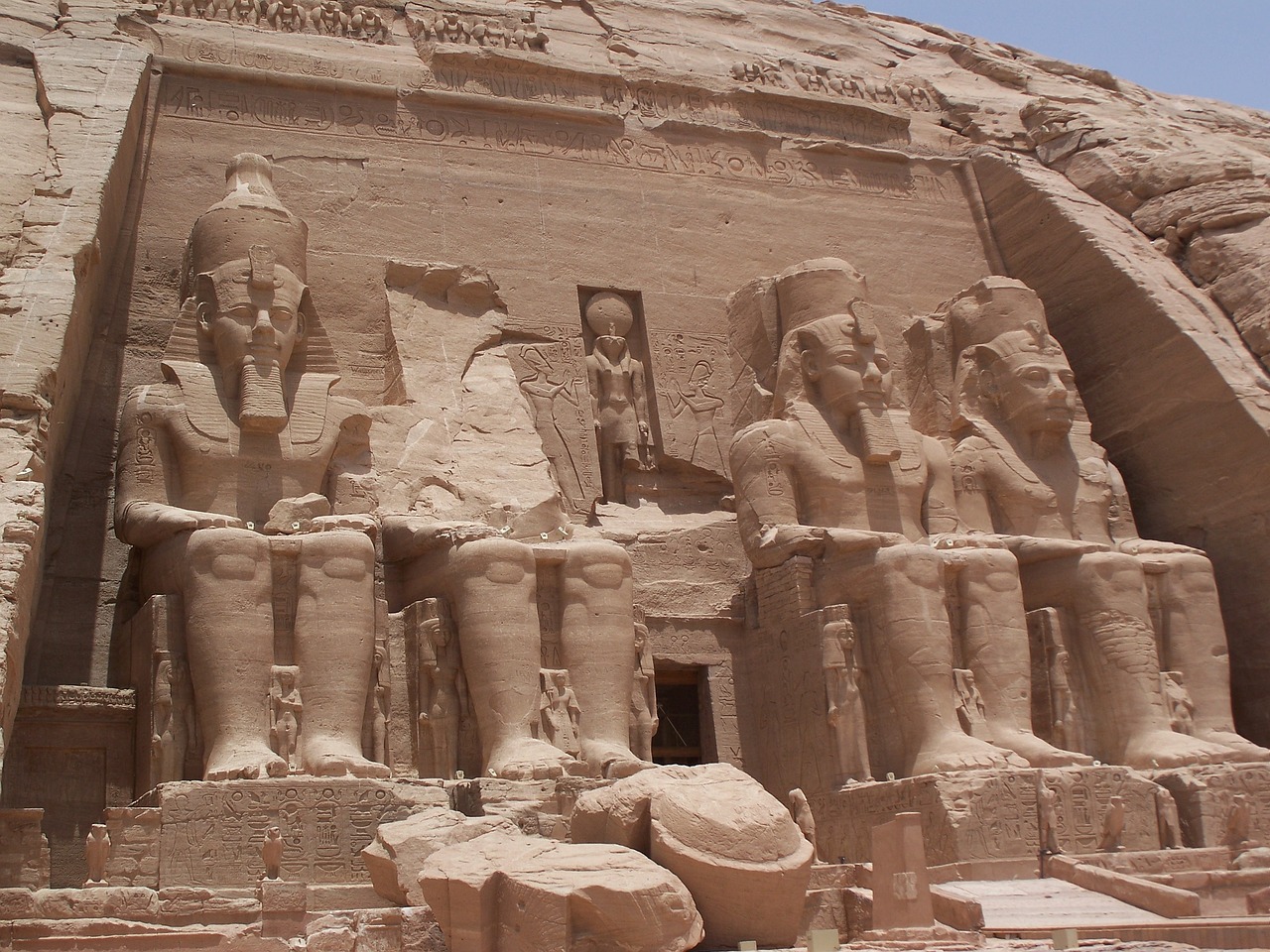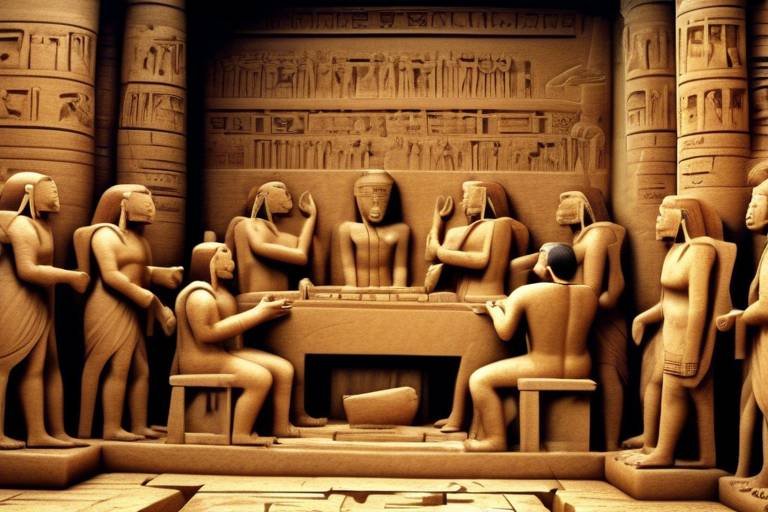The Mystery of the Ancient Hellenistic Art
Embark on a journey through time and space to uncover the mesmerizing enigma of Ancient Hellenistic Art. This artistic era, born from the ashes of Alexander the Great's conquests, holds within it secrets and stories waiting to be unraveled.
Imagine standing before a Hellenistic sculpture, feeling the emotions captured in stone, the intricate details that bring life to the inanimate. These sculptures, with their dynamism and realism, speak volumes about the artistic prowess of their creators.
Delve into the world of mythology as portrayed through Hellenistic art. Gods and goddesses, heroes and heroines, all come to life in marble and paint, weaving tales of old for the modern viewer to ponder.
Technological advancements of the time paved the way for innovative artistic techniques that revolutionized the art world. From lifelike details to intricate designs, Hellenistic artists pushed the boundaries of what was thought possible.
Centers of artistic excellence such as Pergamon, Rhodes, and Alexandria became hubs of creativity, fostering cultural exchange and leaving a lasting imprint on the world of art. The legacy of these cities continues to inspire artists to this day.
But Hellenistic art is not confined to sculptures alone. Mosaics, pottery, coinage—all bear the hallmarks of Hellenistic influence, showcasing the diversity and reach of this artistic period.
As we gaze upon Hellenistic art today, we are transported back in time, feeling the echoes of a bygone era reverberate through the centuries. The legacy of Hellenistic art lives on, continuing to captivate and inspire audiences worldwide.
Unravel the layers of symbolism woven into Hellenistic art, from allegorical motifs to subtle political messages. Each piece holds a story within a story, waiting for the curious mind to decipher its hidden meanings.

The Origins of Hellenistic Art
Exploring the enigmatic beauty and cultural significance of Hellenistic art, which flourished in the Mediterranean world after Alexander the Great's conquests. Unveiling the artistic techniques, themes, and influences that shaped this period of creativity and innovation.
Tracing the roots of Hellenistic art back to the fusion of Greek, Egyptian, and Eastern artistic traditions. Understanding how these diverse influences blended to create a unique and captivating artistic style.
Hellenistic art emerged as a fusion of various cultural influences, blending the artistic traditions of the Greeks, Egyptians, and Eastern civilizations. This amalgamation gave rise to a new and distinctive artistic style that captivated audiences with its unique blend of realism and grandeur. The interplay of these diverse influences created a rich tapestry of artistic expression that set Hellenistic art apart from its predecessors.
The vibrant multicultural environment of the Hellenistic world provided artists with a rich palette of artistic techniques and themes to draw upon. The fusion of Greek naturalism, Egyptian symbolism, and Eastern exoticism resulted in artworks that were both familiar and exotic, striking a balance between the known and the mysterious. This blending of artistic traditions laid the foundation for the captivating beauty and cultural significance of Hellenistic art.
By delving into the origins of Hellenistic art, we uncover a rich tapestry of cultural exchange and artistic innovation. The synthesis of diverse artistic traditions not only shaped the aesthetics of Hellenistic art but also reflected the interconnected nature of the ancient world. Through the exploration of these origins, we gain a deeper appreciation for the enigmatic beauty and cultural significance of Hellenistic art.
Exploring how Greek mythology served as a rich source of inspiration for Hellenistic artists. Analyzing the portrayal of mythological figures and stories in Hellenistic sculptures and paintings.
Investigating the innovative techniques and tools developed by Hellenistic artists to achieve lifelike details and intricate designs in their works. Understanding the advancements that revolutionized the art world during this period.
Highlighting the prominent artistic centers of the Hellenistic world, such as Pergamon, Rhodes, and Alexandria. Exploring how these cities fostered artistic creativity and cultural exchange, leaving a lasting legacy on the art world.
Diving into the diverse forms of artistic expression in the Hellenistic period, including mosaics, pottery, and coinage. Recognizing the wide-ranging influence of Hellenistic art on various mediums and artistic practices.
Reflecting on the enduring impact of Hellenistic art on contemporary artistic movements and cultural expressions. Examining how the legacy of Hellenistic art continues to inspire and captivate audiences worldwide.
Decoding the hidden meanings and symbols embedded in Hellenistic artworks, from allegorical motifs to political messages. Delving into the deeper layers of significance that enrich the understanding of Hellenistic artistry.

Key Characteristics of Hellenistic Sculpture
Hellenistic sculpture, a pinnacle of artistic expression, is characterized by a unique set of features that distinguish it from earlier Greek art forms. One of the key characteristics of Hellenistic sculpture is its emotional realism, where sculptors strived to capture the depth of human emotions in their works. This departure from the idealized forms of Classical Greek sculptures brought a new level of drama and intensity to the art world.
Moreover, Hellenistic sculpture is known for its intricate detailing, with artists showcasing a remarkable attention to anatomical accuracy and fine craftsmanship. The sculptures of this period often exhibit a high level of texture and ornamentation, adding a sense of richness and complexity to the artwork.
Another defining characteristic of Hellenistic sculpture is its dynamic poses, which convey movement and action in a way that was unprecedented in earlier Greek art. Sculptors masterfully captured moments of tension, movement, and expression, creating a sense of energy and vitality in their sculptures.

The Influence of Mythology in Hellenistic Art
Mythology played a pivotal role in shaping the rich tapestry of Hellenistic art, infusing it with symbolism, narrative depth, and cultural significance. The ancient myths and legends of Greece served as a boundless wellspring of inspiration for Hellenistic artists, offering a vast array of characters, stories, and themes to explore and interpret.
One of the key aspects of the influence of mythology in Hellenistic art was the portrayal of mythological figures in sculptures and paintings. Artists skillfully captured the essence of gods, heroes, and mythical creatures, imbuing them with a sense of grandeur, power, and emotion. These representations not only celebrated the mythic pantheon but also reflected the values, beliefs, and aspirations of Hellenistic society.
Moreover, mythology provided artists with a rich symbolic language to convey complex ideas and messages. Allegorical motifs, such as the labors of Hercules or the trials of Perseus, were often depicted in artworks to convey moral lessons, philosophical concepts, or political allegiances. Through these symbolic narratives, Hellenistic art transcended mere aesthetic beauty to communicate deeper layers of meaning and significance.
Furthermore, the influence of mythology extended beyond individual artworks to shape the overarching themes and motifs of Hellenistic artistic production. Mythological scenes and narratives were recurrent subjects in sculptures, paintings, and mosaics, creating a cohesive visual language that resonated with viewers and patrons alike.
In essence, the influence of mythology in Hellenistic art was profound and multifaceted, enriching the artistic landscape of the ancient world with timeless stories, universal themes, and enduring symbols that continue to inspire and fascinate audiences to this day.

Technological Advancements in Hellenistic Art
During the Hellenistic period, artists made significant strides in advancing the technological aspects of their craft, pushing the boundaries of artistic expression. One notable innovation was the use of pointing machines, which allowed sculptors to replicate precise measurements and proportions from smaller models onto larger marble blocks. This technique revolutionized the process of sculpting by enabling artists to achieve greater accuracy and detail in their works.
Furthermore, Hellenistic artists developed sophisticated casting techniques that enabled them to create intricate bronze sculptures with remarkable precision. By perfecting the art of bronze casting, artists were able to produce sculptures with intricate designs and lifelike textures, showcasing their mastery of the medium.
Another technological advancement in Hellenistic art was the refinement of polychromy, the practice of painting sculptures in vibrant colors. This technique added a new dimension to sculptural works, bringing them to life with vivid hues and enhancing the emotional impact of the artwork.
Moreover, the use of drills and chisels allowed Hellenistic artists to carve intricate details and textures with unparalleled precision. These tools enabled artists to create elaborate patterns, delicate features, and realistic textures, elevating the quality of their sculptures to new heights.
Overall, the technological advancements in Hellenistic art not only transformed the way artists approached their craft but also paved the way for future innovations in the art world, leaving a lasting impact on artistic practices for centuries to come.

Hellenistic Artistic Centers and Their Impact
During the Hellenistic period, several artistic centers emerged as hubs of creativity and cultural exchange, shaping the course of art history. One of the most renowned centers was Pergamon, known for its monumental sculptures and architectural achievements. The Great Altar of Pergamon, a masterpiece of Hellenistic art, showcased the city's artistic prowess and cultural sophistication.
Rhodes, another significant artistic center, was celebrated for its bronze sculptures, including the famous Colossus of Rhodes, one of the Seven Wonders of the Ancient World. The city's vibrant artistic community attracted talented sculptors and painters, contributing to the rich artistic landscape of the Hellenistic world.
Alexandria, with its cosmopolitan atmosphere and intellectual vibrancy, became a melting pot of artistic influences from across the Mediterranean and beyond. The city's renowned Museum and Library fostered artistic innovation and scholarly pursuits, making it a beacon of creativity in the ancient world.
These artistic centers not only produced exceptional works of art but also served as cultural crossroads where artistic ideas and techniques were exchanged and refined. The legacy of Pergamon, Rhodes, and Alexandria continues to inspire artists and art enthusiasts, showcasing the enduring impact of Hellenistic art on the world of art and culture.

Exploring Hellenistic Art Beyond Sculpture
When delving into the world of Hellenistic art, one cannot overlook the diverse forms of artistic expression that thrived beyond the realm of sculpture. From intricate mosaics to exquisite pottery and even the artistic design of coinage, the Hellenistic period showcased a rich tapestry of creative endeavors that extended far beyond the chisel and marble.
One of the most fascinating aspects of Hellenistic art is the utilization of mosaics as a medium for artistic expression. These intricate designs composed of tiny colored stones or glass, known as tesserae, adorned floors and walls with vibrant scenes and patterns. Mosaics not only served as decorative elements but also conveyed narratives and symbolism, offering a glimpse into the artistic prowess of the period.
Additionally, Hellenistic pottery stands out for its exquisite craftsmanship and artistic flair. From delicate amphorae to ornate vases, pottery in the Hellenistic world was not merely utilitarian but also a canvas for artistic innovation. Decorated with intricate designs, mythological motifs, and scenes from daily life, Hellenistic pottery reflects the cultural richness and artistic sophistication of the era.
Furthermore, the art of coinage in the Hellenistic world transcended mere monetary value to become a form of artistic expression. Coins were minted with intricate designs, depicting rulers, deities, and symbolic imagery that conveyed political messages and cultural identity. The artistry of Hellenistic coinage not only served practical purposes but also showcased the creativity and skill of the period's artisans.
Exploring Hellenistic art beyond sculpture unveils a world of artistic diversity and innovation, where creativity knew no bounds and artistic expression flourished in various mediums. From the intricate beauty of mosaics to the functional elegance of pottery and the symbolic significance of coinage, the artistic legacy of the Hellenistic period continues to captivate and inspire art enthusiasts and historians alike.

The Legacy of Hellenistic Art in the Modern World
The legacy of Hellenistic art continues to resonate in the modern world, transcending time and geography to influence contemporary artistic movements and cultural expressions. The artistry of the Hellenistic period, with its emphasis on emotional realism and intricate detailing, has left an indelible mark on the art world, inspiring generations of artists and art enthusiasts.
One of the most significant aspects of the legacy of Hellenistic art is its enduring impact on sculpture and portraiture. The dynamic poses and lifelike expressions found in Hellenistic sculptures have served as a source of inspiration for artists throughout history, from the Renaissance to the present day. The attention to detail and the ability to capture the essence of human emotion in stone have set a standard for artistic realism that continues to be admired and emulated.
Beyond the realm of sculpture, the influence of Hellenistic art can be seen in various other artistic mediums, such as painting, architecture, and decorative arts. The fusion of Greek, Egyptian, and Eastern artistic traditions in Hellenistic art has contributed to a rich tapestry of artistic expression that continues to inspire creativity and innovation.
Moreover, the themes and motifs present in Hellenistic art, often drawn from Greek mythology and history, have provided a source of inspiration for storytellers, poets, and filmmakers. The enduring popularity of mythological themes in literature and popular culture can be traced back to the rich visual tradition established by Hellenistic artists.
In the modern world, museums and art institutions around the globe showcase Hellenistic artworks, allowing audiences to experience firsthand the beauty and complexity of this ancient artistic tradition. The legacy of Hellenistic art serves as a bridge between the past and the present, connecting us to the artistic achievements of our ancestors and reminding us of the timeless power of creativity and imagination.

Unraveling the Symbolism in Hellenistic Art
Delving into the mesmerizing world of Hellenistic art unveils a tapestry of symbolism woven into each masterpiece. Beyond the surface beauty lies a deeper layer of meaning, waiting to be deciphered by those who seek to unravel the mysteries of ancient artistry.
One of the fascinating aspects of Hellenistic art is the use of allegorical motifs to convey profound messages. Sculptures and paintings were not merely aesthetic creations but carriers of symbolic significance, reflecting the values, beliefs, and ideologies of the time. Each figure, each pose, each detail was infused with symbolic intent, inviting viewers to interpret and contemplate the hidden meanings.
Political messages also permeated Hellenistic art, serving as a tool for propaganda and expression of power. Rulers and leaders commissioned artworks to glorify their reign, using symbols and imagery to assert dominance and authority. Through art, they sought to shape public perception and cement their legacy in the annals of history.
Moreover, religious symbolism played a crucial role in Hellenistic art, reflecting the spiritual beliefs and practices of the ancient world. Mythological figures were not merely characters from stories but embodiments of divine forces and archetypal ideals. Artists skillfully imbued their works with religious symbolism, inviting viewers to contemplate the mysteries of the cosmos and the nature of existence.
Deciphering the symbolism in Hellenistic art requires a keen eye and a deep understanding of the cultural context in which these artworks were created. Each symbol, whether overt or subtle, carries layers of meaning waiting to be unraveled, offering a glimpse into the rich tapestry of ancient thought and creativity.
As we embark on a journey through the intricate world of Hellenistic art, let us not only admire the beauty of these masterpieces but also seek to uncover the hidden symbolism that enriches our understanding of this enigmatic period in history.
Frequently Asked Questions
- What is Hellenistic art?
Hellenistic art refers to the artistic style and cultural expression that emerged in the Mediterranean world after the conquests of Alexander the Great. It is characterized by a blend of Greek, Egyptian, and Eastern artistic traditions, showcasing emotional realism, intricate detailing, and dynamic poses.
- What are the key characteristics of Hellenistic sculpture?
Hellenistic sculpture is known for its emotional depth, attention to detail, and dynamic compositions. Artists in this period aimed to capture realistic human emotions and movements, often depicting mythological figures and historical events with great skill and creativity.
- How did mythology influence Hellenistic art?
Greek mythology played a significant role in inspiring Hellenistic artists. Mythological stories and characters were frequently depicted in sculptures and paintings, serving as a rich source of inspiration for exploring human emotions, virtues, and vices through artistic expression.
- What is the legacy of Hellenistic art in the modern world?
The legacy of Hellenistic art continues to influence contemporary artistic movements and cultural expressions. Its innovative techniques, themes, and storytelling have left a lasting impact on the art world, inspiring artists and captivating audiences around the globe.



















